How To Make a Workout Plan in Google Sheets [With Template]
Creating a workout plan in Google Sheets can be an easy way to track and analyze your progress. With the right Google Sheets workout template, you can customize the spreadsheet to fit your needs. You can use it to track sets, reps, rest periods, and weights lifted for every exercise.
Let’s dive in and see how you can use a Google Sheets template to create your own workout plan.
If you’re more of a visual learner, then check out the video tutorial below:
Learn how to make a workout plan using Google Sheets by exploring these topics:
- How To Create a Workout Plan in Google Sheets
- How To Track a Workout in Google Sheets
- Frequently Asked Questions
- How to Access Google Sheets Workout Template
How To Create a Workout Plan in Google Sheets
Here’s a step-by-step guide on how to make a workout plan in Google Sheets:
- Log In to Your Google Account
- Access Google Sheets Workout Templates
- Choose Your Workout Template
- Make a Copy of the Workout Template
- Design the Workout Plan
- Delete the Empty Rows, Columns, and Tabs
NOTE
If you are looking to design your workout plan in a Microsoft Excel spreadsheet application instead, check out this article on how to make a workout plan in Excel.
1. Log In to Your Google Account
To begin with, you must first log in to your Google account using your Gmail account credentials.
Or if you don’t have a Google account, you will need to create one for free.
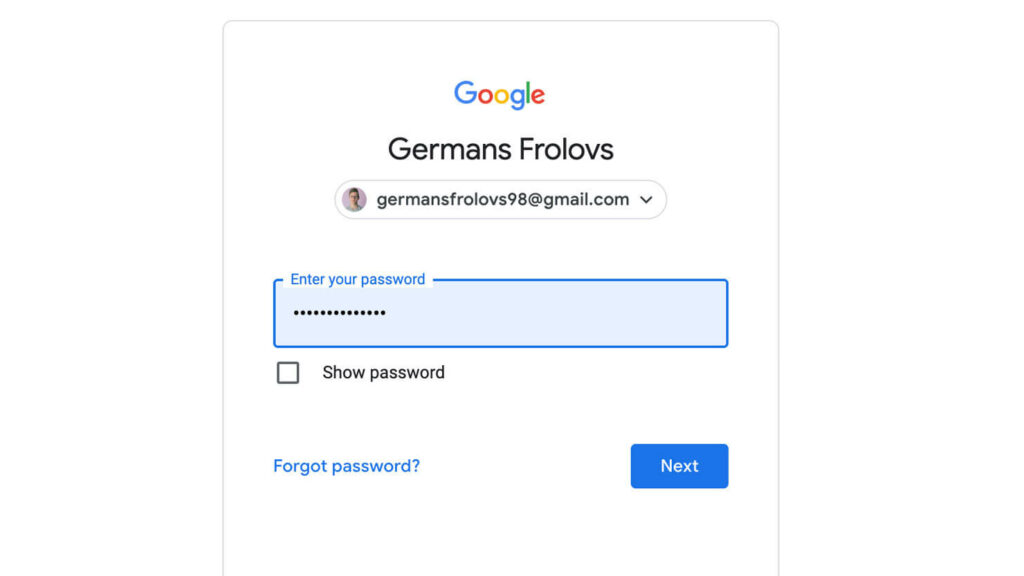
2. Access Google Sheets Workout Templates
Next, you will need to access my free workout templates.
You can do this by:
- Going to the Google sheets workout templates page.
- Clicking the “Download Templates” button
- Filling out and submitting the form
- Confirming your email address by clicking the verification link sent to your inbox
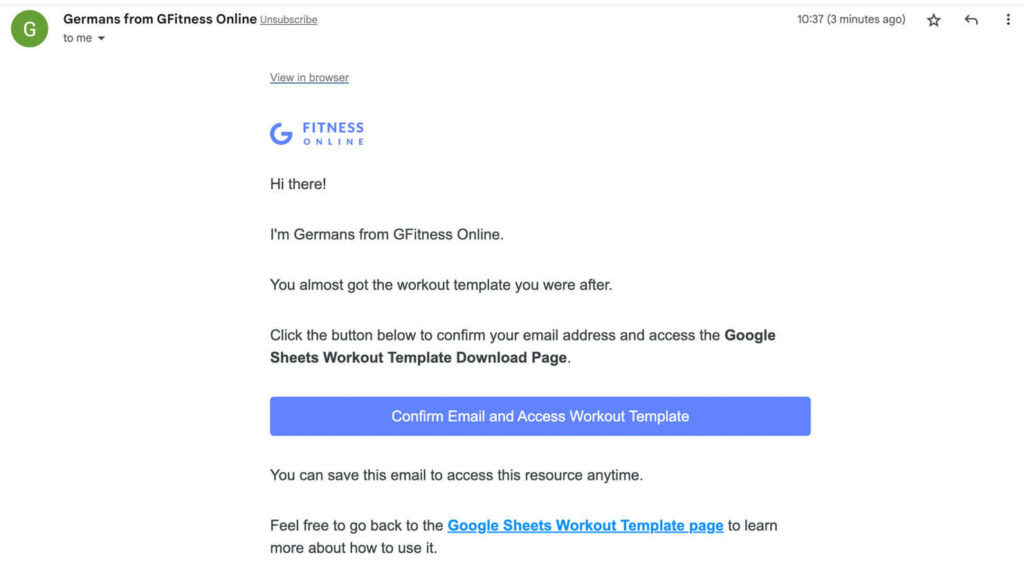
Then you will be redirected to the page where you can access the template(s) of your choice.
3. Choose Your Workout Template
Once you are redirected to the page with all the templates, select the one that suits your needs.
The templates will differ in terms of:
- The number of exercise slots per workout that allow you to track 8 or 12 exercises (Basic Templates).
- You will be able to track the weight used and total reps performed for all sets for a given exercise (Basic Templates). Or the weight used and reps performed per each set of a given exercise (Advanced Template).

4. Make a Copy of the Workout Template
Once you know which template you want to use, you can make a copy of it.
To do this:
- Click on the download button of the appropriate template
- Then hit the blue “Make a Copy” button
- This will create a copy of the template in your Google Drive
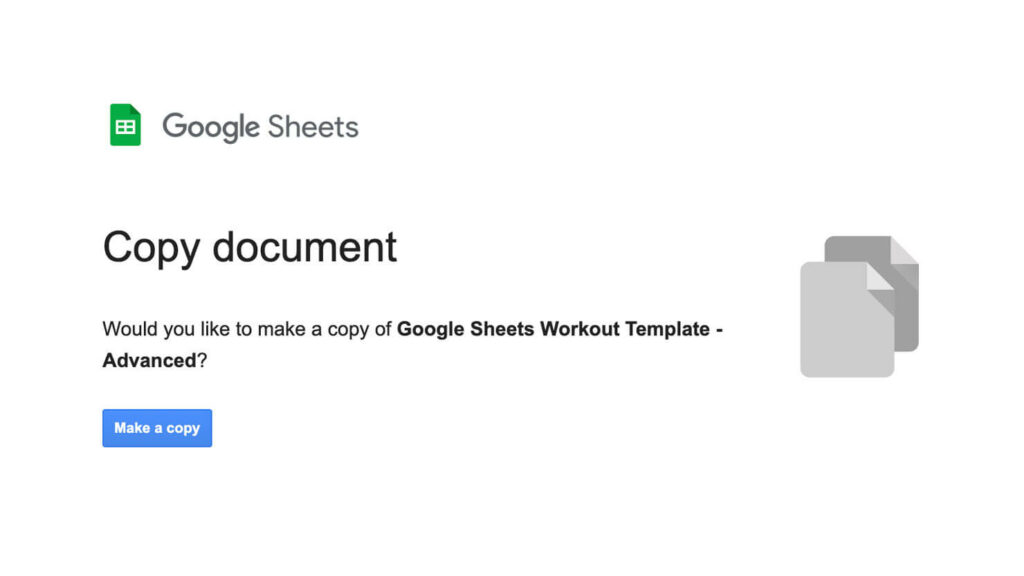
You can then change the name of the template to something that you can recognize and remember. As well as save it in the folder of your choice.

5. Design the Workout Plan
When you’ve made a copy, you can now design the workout schedule.
First, go to the “Workout Setup” tab.
Then, fill in the information for every exercise in your workout routine:
- Muscle Group: the primary muscle group you use when performing any given exercise.
- Exercise: exercise you do for the particular muscle group.
- Sets: the number of sets of any given exercise you want to perform.
- Reps: repetitions or reps for short (number of repetitions you would do during a single set).
- Rest (Seconds): the time spent resting between sets.
- Weight: the weight you want to use when doing the exercise. It can be either in kilograms (kg) or pounds (lb), depending on which you prefer to use.
- Note: here you can write any kind of notes for yourself. For example, “superset XX exercise with XX exercise”, “use W-shaped bar”, “remember to keep core tight”, etc.

6. Delete the Empty Rows, Columns, and Tabs
Lastly, you can delete any empty rows, columns, and tabs. Although it’s optional.
This includes:
- Deleting any unused rows or columns that are not part of your training schedule.
- Deleting any blank tabs representing weeks, toward the end of the template that you don’t plan to use.
You can delete by right-clicking on the cell, column, or tab respectively, and then selecting the “Delete” option.
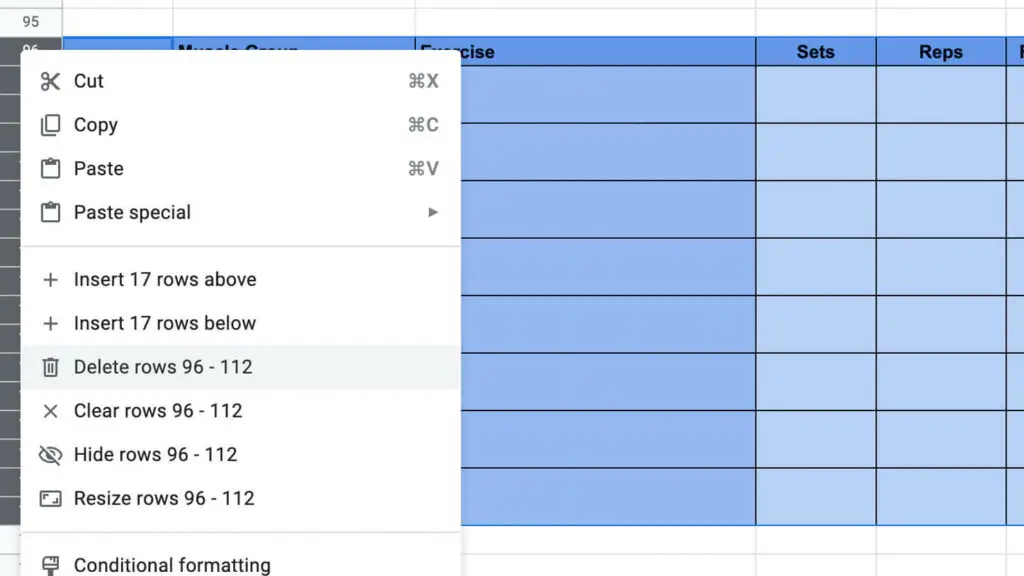
Once you have done this, your weight training workout plan is now “clean” and ready for use.
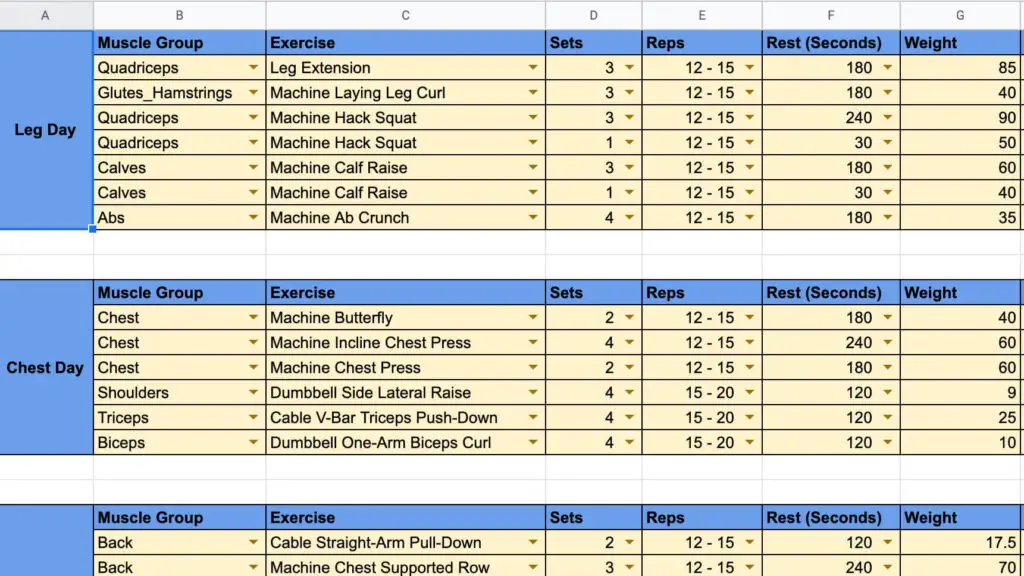
How To Track a Workout in Google Sheets
Now that you have your workout plan in place, it’s time to start tracking your workouts.
Here’s how:
- Open Your Workout Plan in Google Sheets
- Go to the Appropriate Week’s Tab
- Enter Data As You Complete Every Set
- Analyze Your Progress Week-to-Week
1. Open Your Workout Plan in Google Sheets
First, open up the workout plan you created in Google Sheets.
You can do this by:
- Logging into your Google account
- Going to your Google Drive
- Clicking on the file you created
Alternatively, you can download the Google Sheets app on your mobile device and access the workout plan from there.
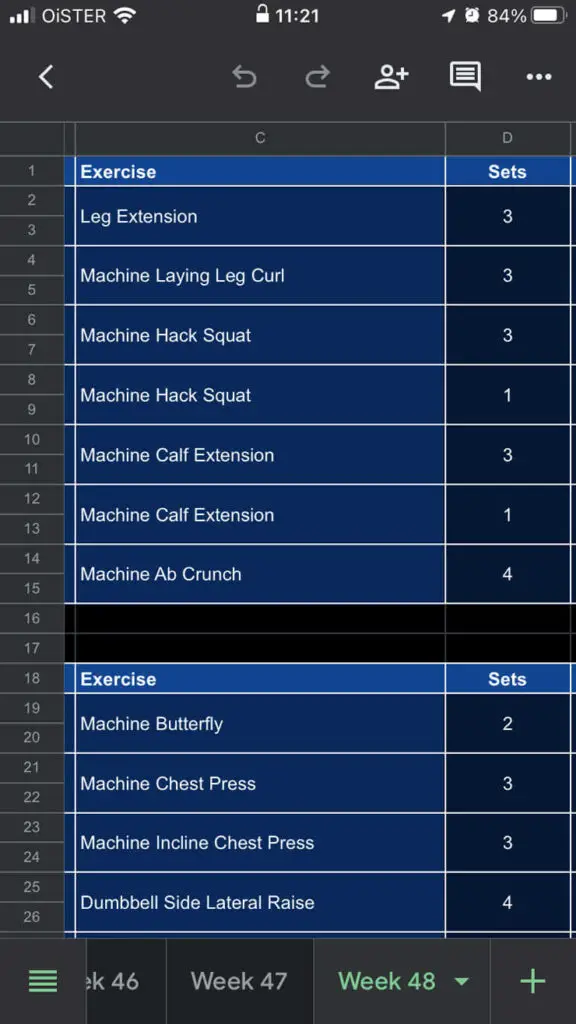
2. Go to the Appropriate Week’s Tab
Once you’ve opened up the workout plan, go to the tab that corresponds to the workout week you are currently in.
This is where you will enter your workout data for that particular week.
NOTE
You can name workout weeks according to your own preferences. For example, “Week 1”, “Week 2”, and so on, to represent training weeks. Or name them according to the calendar week you are in. For example, “Week 46”, and “Week 47”, would represent weeks between the dates of November 14 – November 20, 2022, and November 21 – November 27, 2022, respectively.
3. Enter Data As You Complete Every Set
When you are ready to do your workout, enter the data as you do your workout and complete each set:
- First, you would need to enter the weight used.
- Then you would need to enter the number of reps you were able to do for that set.
- Continue entering the number of reps performed until you have finished all sets for a given exercise.
- Then continue with the next exercise, and so on.
As you continue following the workout plan in the next weeks, keep entering data as you go.
Note that the template pulls data from the previous weeks. To show your results from the past week so that you could try and beat them, and make progress in your routine.
So, when entering data you must, first, delete the content in a cell from the previous weeks and enter the actual data for the current week.
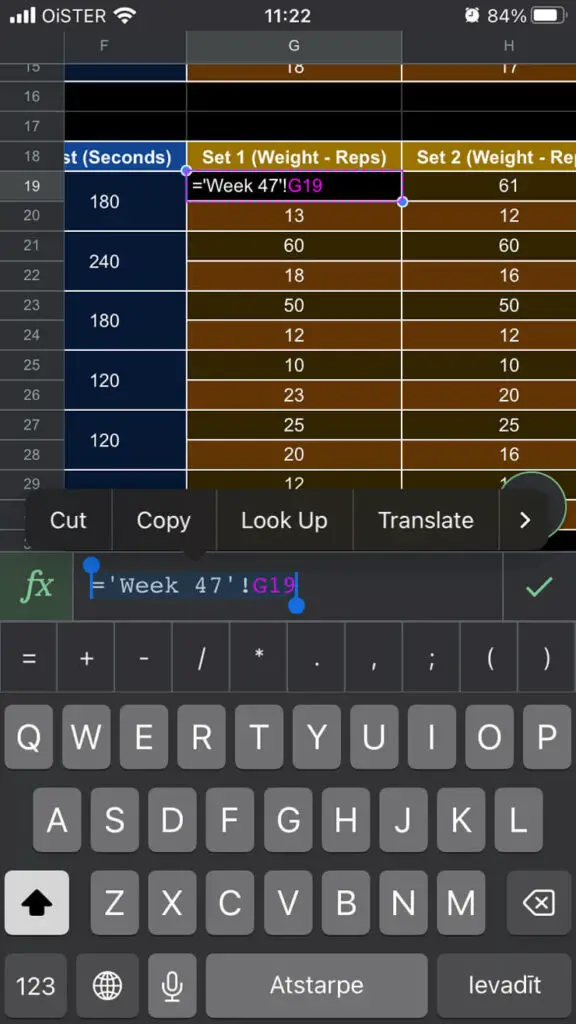
NOTE
The basic workout log template allows tracking the weight used and reps performed for total sets of a given exercise. An advanced template allows tracking of the weight used and reps performed for each set. Such a template can be more helpful if you are following a certain rep scheme, or want to track your workouts in more detail.
You will notice that in addition, the template is built in a way that it automatically calculates the total volume for each exercise. This is the total number of reps performed multiplied by the weight used.
4. Analyze Your Progress Week-to-Week
Once you have entered the data for a few weeks, you can start analyzing your progress.
To do that go to the “Performance Tracker” tab and observe the changes.
There you will find a “Volume Tracker” table that displays the total volume (sets x reps x weight) lifted for each exercise, across all weeks.
You can view the data for a specific exercise – the volume as well as the percentage change in comparison to the previous week.
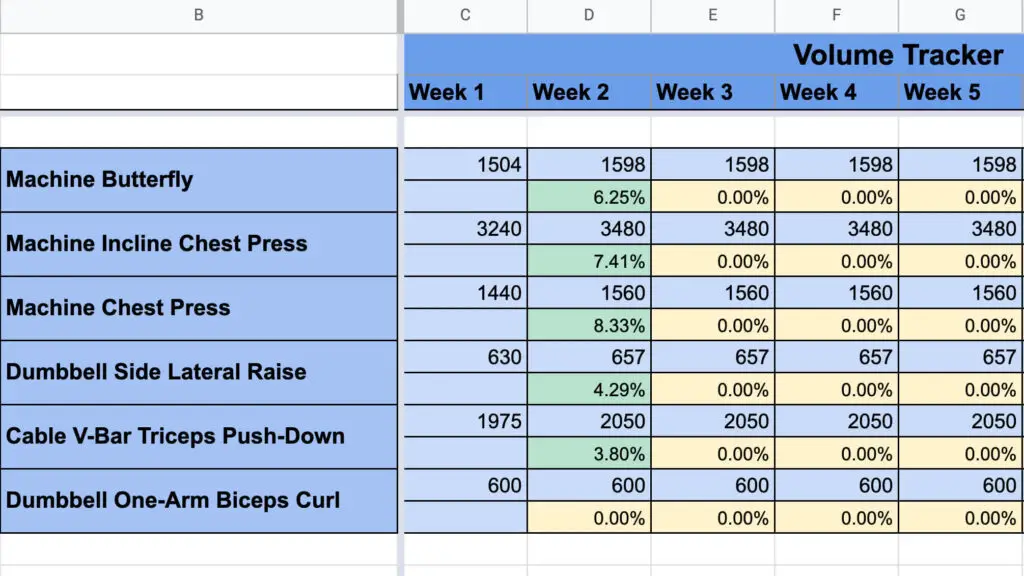
Plus, conditional formatting is applied to make it easier to spot trends. Specifically, whether the percentage change in comparison to the previous week is:
- Positive (green color)
- Negative (red color)
- No change at all (yellow color)
Frequently Asked Questions
How to Add New Exercises to the Google Sheets Workout Template Database?
Follow these steps to add new exercises to the template database:
- Go to the “DATA” tab.
- Find the appropriate muscle group to which you want to add the new exercise.
- Click on the empty cell right under the last exercise that represents exercises associated with that muscle group.
- Type in the name of the exercise, and press “Enter”.

Note that you can also change the names of the existing exercises by double-clicking on the cell and editing the exercise name.
From now on, the new/edited exercise will appear in the “Exercise” drop-down menu in the “Workout Setup” tab for that particular muscle group.
How to Edit the Available Number of Sets, Rep Ranges, and Rest Periods?
Follow these steps to edit the options for the number of sets, rep ranges, and rest periods:
- Go to the “DATA” tab.
- Find the column with a header name that represents what you want to edit.
- Click on the empty cell right under the last option.
- Type in the new selection option you want to add.

Remember that you can also change the current option(s) by double-clicking on it and changing the value.
Now, new/edited options will be available from the drop-down menus when setting up your workout in the “Workout Setup” tab.
Can I Follow My Google Sheets Workout Plan Using a Phone Or Tablet?
You can access the workout plan in Google Sheets with your mobile device – phone or tablet.
You will need to install the free Google Sheets app on your device and log in with the same Google account that you used to create and save the workout plan.
You can download the Google Sheets app from the App Store or Google Play.
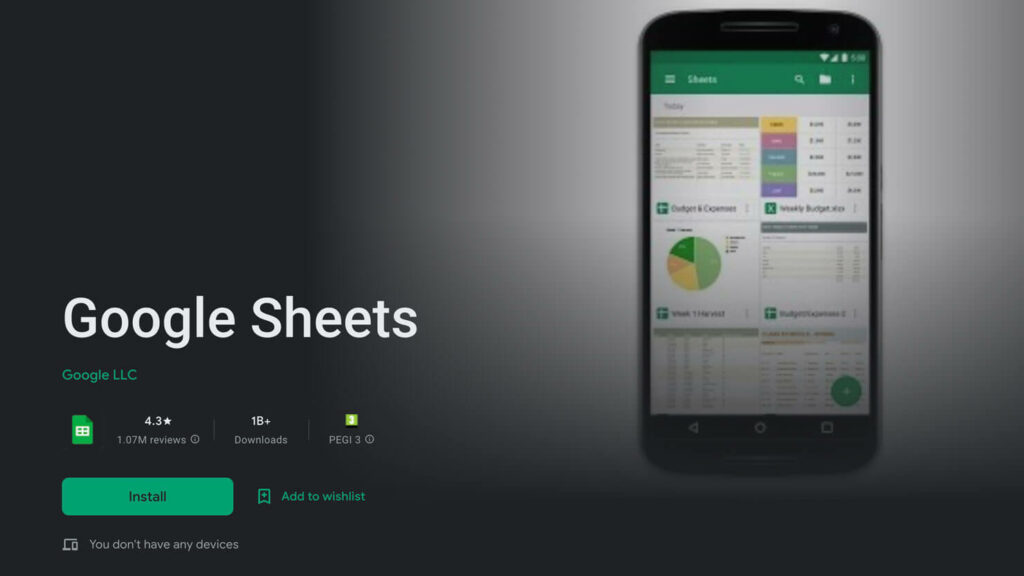
Why Can the Workout Plan Only Last For 12 Weeks?
I set a limit of 12 weeks to the workout plan template. I think that it is the longest period that you can follow one workout routine without switching it up.
After 12 weeks, you will probably need to change your workout routine or at least some of the exercises. Thus, after a maximum of 12 weeks, I suggest creating a copy of the template and creating a new workout routine.
What If I Need to Change My Workout Plan in Google Sheets?
If you need to change your workout plan while following it, you have a few options:
- If you have just started following the workout plan, you can go to the “Workout Setup” tab and edit the exercises, sets, reps, etc.
- If you have been following the plan for a few weeks, then you can go to the current week’s tab and just type in the new exercises, sets, and reps. This data will also get copied to the consecutive weeks so it will be applied to the rest of your workout plan. However, the new data will not be correctly recorded in the “Performance Tracker” tab, especially if you change the exercise.
- The last option is to just create a copy of the blank workout template and make a new workout plan from the beginning. This way, all the data from the “Performance Tracker” tab will be correctly recorded.
How to Access Google Sheets Workout Template
Here is how you can access the workout templates:
- Fill in your email address in the form below.
- Confirm your email address by clicking on the link in the email you will receive.
- You will then be redirected to the workout template download page.
- Click the button to access the Google Sheets template you want.
- Click “Make a copy” to save the template to your own Google Drive.
If you have any questions about the template or have a suggestion for a new feature, feel free to contact me. I am always open to feedback and suggestions.
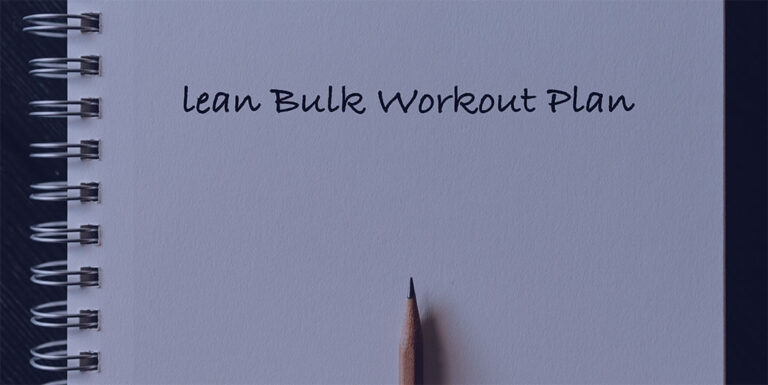
![How To Make a Workout Plan in Excel [With Template]](https://gfitnessonline.com/wp-content/uploads/2022/12/make-workout-plan-excel-768x384.jpg)

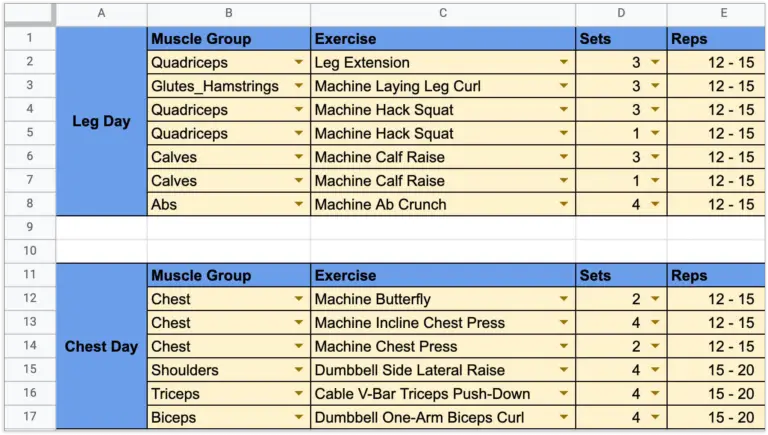


Hello! This is exactly what I needed. just wondering if we can do supersets??
Hi Kristina!
Good to hear you found what you were looking for 🙂
Yes, you can also do supersets. I suggest adding exercises as you would usually do and in the “Notes” column specify that it would be a “superset”.